by Tom Gaylord
Writing as B.B. Pelletier
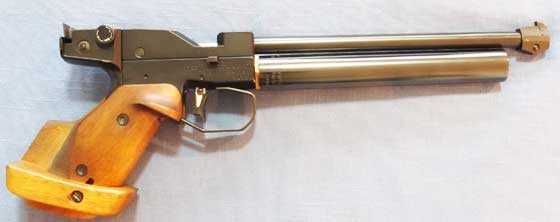
FWB model 2 target air pistol.
This report covers:
- Too slow!
- My first Harley
- Consistant?
- H&N Finale Match Pistol pellets
- RWS R10 pistol pellets
- The test
- Sight picture
- H&N Finale Match Rifle
- Qiang Yuan Olympic
- H&N Finale Match Pistol
- Qiang Yuan Training
- RWS R10 Pistol
- Conclusions
This will be a special report that combines both velocity testing and accuracy testing of the FWB model 2 10-meter target pistol. After I published the last report and made the pistol look bad because its velocity wasn’t very stable, reader Carel told me I might have the power set too low. Carel is the man I bought the gun from, so I took his advice and dialed the velocity up. After two full turns on the power screw I got an average velocity of 534 f.p.s. with the Qiang Yuan Training pellets that had given me fits before. This time the maximum spread was just 10 f.p.s. with the same pellet that previously gave a 98 f.p.s. spread.
Too slow!
If you read Part 2 you’ll see I was arbitrarily trying to set a velocity in the 460 to 480 f.p.s. range to save gas. I didn’t even check the reservoir volume before choosing that speed, but it’s 53 grams, which is enough for hundreds of shots at high velocity. In a false quest for economy I was trying to force the pistol to shoot at a speed slower than its powerplant was designed for.
My first Harley
This experience reminded me of my first Harley Davidson, back around 1967. It was a 1947 panhead that is a nominal 74 cubic-inch machine. I met the owner as we both rode home from pulling a swing shift in Santa Clara, California in the 1960s — me at National Can Corporation and him at Kaiser Permanente. He caught up to me on a long stretch of deserted road at 12:30 in the morning and we rode together back to Campbell. His motorcycle was backfiring and even belching fire out the carburetor that didn’t have an air cleaner, so I kept slowing down until we were going 35 m.p.s. I normally rode 55 on that stretch, but his bike just didn’t seem to be able to do it.
He waived us into an all-night bowling alley in Saratoga, where we introduced ourselves and got a cup of coffee. He asked me if my little Benelli 125 could go any faster because it turned out he was driving in second gear to go as slow as I was going! His bike was bored out to 1500ccs and had a hot cam. It did not like going slow.
I ended up buying that bike from him about a month later and owned it for a couple years. It really did not like to go slow! I laid rubber on every start, just to keep from stalling. That was when I learned my lesson about going too slow. Some things just don’t like it, and this model 2 Feinwerkbau pistol is one of them.
Consistant?
When I started this test today the first 3 shots were with the same Qiang Yuan training pellets, to see where they would be from a cold gun after a week’s layoff. Those 3 shots registered 533, 531 and 530 f.p.s. — so the gun is extremely consistent. Now I could complete the test. No repairs are required, thank you very much.
H&N Finale Match Pistol pellets
Next I tried some H&N Finale Match Pistol pellets in the pistol. They averaged 551 f.p.s. with a spread from 541 to 564 f.p.s. That’s 23 f.p.s.
RWS R10 pistol pellets
The last pellet I tested was the RWS R10 pistol pellet that averaged 571 f.p.s. from the model 2. The spread went from 558 to 583 f.p.s. That’s a 25 f.p.s. spread.
As hot as this pistol is, I may try some rifle weight target pellets in the accuracy test that I’m about to do. This is almost like shooting a target rifle. But before we go there I want to say a word about this velocity test. This test demonstrates that numbers chosen arbitrarily may not be the best way to adjust an airgun. In this case, I was trying to make the gun do something it wasn’t designed to do. A precharged pneumatic with a regulator might be able to shoot slower, but this pistol runs on CO2 and it isn’t as forgiving. You have to take the gas into account when setting up the gun.
The test
I’ll shoot at 10 meters, using a sandbag rest. I’ll shoot 5-shot groups rather than 10, because if this pistol groups like it should, 5 shots should tell us what we need to know.
I started the test and got groups that were way too large for a pistol like this. I shot a group with every pellet, which was 25 shots. Then I got a wild hair and shot a 5-shot group offhand. I did throw some shots, but I also did better offhand than some of the pellets did shooting off the rest.
Sight picture
The problem was the sight picture. When shooting from the rest I had been holding the pistol a couple inches closer to my eye than I do when I shoot one-handed. So I devised a way to rest the gun and shoot one-handed. The point of impact changed upwards, but I didn’t bother correcting it. The groups that follow are all shot one-handed off a rest.
H&N Finale Match Rifle
First up were H&N Finale Match Rifle pellets with 4.50mm heads. They were the worst pellets in the pistol, producing a group that measures 0.717-inches between centers.
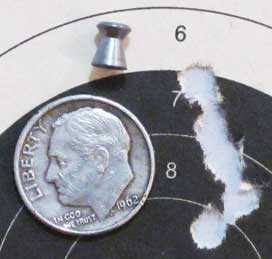
Five H&N Finale Match Rifle pellets made this 0.717-inch group at 10 meters. It is the biggest group of the test.
Qiang Yuan Olympic
The Qiang Yuan Olympic grade pellets put 5 into 0.515 inches at 10 meters. That’s better, but still not as good as I hoped.
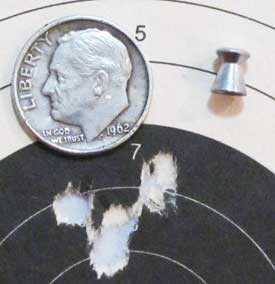
Five Qiang Yuan Olympic grade pellets went into 0.515-inches at 10 meters. Better, but not good enough.
H&N Finale Match Pistol pellets
Next up were H&N Finale Match Pistol pellets with 4.50mm heads. Five of these made a 0.403-inch group at 10 meters. This group looks like I should explore this pellet more.
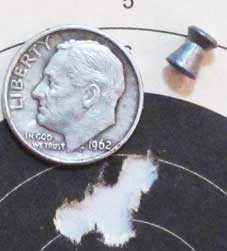
Five H&N Finale Match Pistol pellets made this 0.403-inch group at 10 meters. This looks interesting. Perhaps I should explore this pellet with a different sized head.
Qiang Yuan Training
The next pellet I tried was the Qiang Yuan Training pellet. Five of them went into 0.654-inches at 10 meters. While it might look okay standing on its own, it looks bad in comparison to some of the other groups.
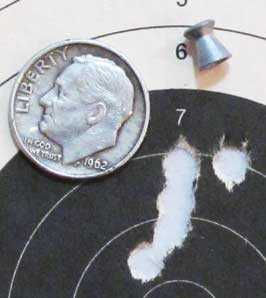
Five Qiang Yuan Training pellets made this group that measures 0.654-inches between centers at 10 meters. This is not the pellet for this pistol.
RWS R10 Pistol
The last pellet I tried was the RWS R10 pistol pellet with a 4.50mm head. Five of these made a 0.456-inch group at 10 meters. This was also the pellet I shot offhand and I am pleased to say I was able to cut a 10 on the first shot. What the rest of my shots scored I won’t say, except to note that most of them were lower than I ever shot in training or in a match when I competed. A lot of water has flowed over the dam!
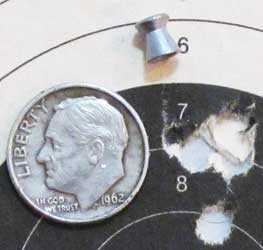
Five RWN R10 Pistol pellets with 4.50mm heads went into 0.456-inches at 10 meters fro a rest.
Conclusions
The FWB model 2 can shoot! I didn’t doubt that it could. What needs to get better is me, and I am working on it.
Having a 10 meter pistol that can always outshoot you is a joy, because you always know where you stand. I have a lot of training to do if I want to get back some of my former ability, and this pistol is good enough to take me there.
I learned that a CO2 target pistol is not as infinitely adjustable as a similar gun in a PCP. With CO2 you have to acknowledge the limitations of the gas. But the pistol has a Feinwerkbau trigger and most of the ergonomics of the newer PCPs, so it is still worlds ahead of my ability. And I paid less than you would for a new gun with less features.

B.B.,
Those are some nice groups at 10 meters. To think that you could better that is amazing. Is the bulk CO2 as temp. sensitive as the 12 gram. cartridges? Is there a “wait time” between shots? Nice fps spreads there.
Harley B.B.? First I heard of that. And you said “first”, there was more? I had a 2000 HD Wide Glide for 5 years. Lot’s of fun. Sold it and got a 4 wheel drive for snow and country. Still miss it, but with getting older and idiots on the road and Deer, maybe for the best. You still have a bike?
All in all, good article, on a couple of fronts,….Chris
You got rid of your bike because you were getting old? Man.
What little is left up on top is mostly white and I was thinking of riding to work this morning. It is down to almost freezing, but the roads are dry. I would rather ride my bike than drive anything else. When I get too old to hold it up any more, I will put training wheels on it or get a tricycle. If I get killed on the bike at least I died having fun.
I’m just bustin’ your chops, man. 😉
RR,
It came down to newer vehicle and 4wd. Glad you still ride. In the recent past, I worked a ton of O.T. and rarely had the time, daylight or energy to ride. I always wanted to be at 100% full alert and not fatigued at all to ride. It was a lifelong dream and I did it with style. Them puppies can be money pits though. Not repairs,…all the add on “bling-bling”. 😉
What did I drive before?,….a ’74 Ford E-100 van with 3 on the tree and no power anything. I drove it for 18 years. Then a ’04 Liberty and now a ’11 Rav 4.
Glad you were just “Bustin’ my chops”,…started to get my feelings hurt there…. 😉
I had walked away from bikes back in the 80s when I met the woman who would be my wife, settled down, raised a kid, yada yada yada. About three years ago my brother-in-law needed some money and made me a sweet offer on his ’06 Night Train. I was not wanting to go further in debt at the time, but my wife said “we are buying the bike”. I am so glad she did. Gotta love her. 🙂
RR,
You sounded like ol’ BD76 there for a moment when I first read it. Ol’ BD would have (not) been kidding though. It was not that long ago he rode a Boss Hoss,…as in Chevy V-8 powered.
Chris,
I should have mentioned that I did not wait between shots, other than the time it takes to reload and sight. Probably 20 seconds or so.
My second Harley was a 46 Knuck, but it never ran. It was a project that was never completed.
B.B.
Chris,
I didn’t answer the bike question. No, I don’t have one. When we married I promised Edith I would not get a motorcycle as long as we were married. She was very afraid of them.
I do ride a bicycle, though.
If I were to get a bike today I am torn between a vintage BMW like an R60 or possibly an R27 and the biggest touring bike I can find. Probably won’t get one, though.
B.B.
Bmw’s are great. In the 90s I used to ride a bmw RS1100.
This was a heavy bike. But it was a smooth bike to ride (once you got the wheels rolling). But it was a bastard to park it in the garage.
I had a few close calls, so I dicided not to ride anymore.
Those vintage bmw’s are fabulous. My old neighbor had a few of them.
B.B.,
Woulda’, Coulda’, Shoulda’,….and maybe,… better off (not). 😉 I can relate.
I was looking at one of the 650 enduros for my next one after the SR500.
Only problem was inseam height.
Reb,
The on and off roads always interested me. Never did it. The HD was heavy but all good once rolling. Good for a 40-50 mph cross wind though. Only moved over about a 1/4 to 1/2 lane!
750# “ish” if I remember correct. Yikes! 😉
I got into some tight spots with my ’81 Honda 650c until I decided that was too heavy for me and got something smaller.
I think my favorite was my KE100 it weighed in @ just over 200#.with 10hp instantly available up to about 60mph but it would rattle every bone in my body after a couple hours.
B.B.,
I think the varying pressure at different levels of gas in the cylinders is the reason why your pistol has velocity swings. FWB fixed the problem by adding a staging/expansion chamber in their models C10/C20.
The Finale Match Rifle (and to a lesser extent the Quiang Yuan Training) groups are interesting. Almost no difference in point of impact laterally and a great deal vertically. Any ideas as to what may be causing that? Actually the whole issue of pellets being liked or disliked by a gun is fascinating. I’ve never had an RWS or JSB work very well in anything I own and H&N’s of one sort or another have always been best. A rifle a friend of mine owns on the other hand is terrible with any of my H&N’s but works best with the inexpensive RWS pellets.
Nowhere,
Not a clue why that happened like that. They shot the same way in the first groups that I did not show, too. Just not right for the gun, I guess.
B.B.
BB,
That is why the only air pistol I have is my Izzy. I will never be able to shoot better than it can and every time that I get my hands on another air pistol, it gets measured up against it.
There is just nothing like shooting an air pistol that, if you do what you are supposed to do, will put the pellet exactly where you want it to be.
I am posting this for someone why contacted me directly. With all the messages and email I get I like to answer general questions here, so everyone can rad them.
Hello Mr Tom Gaylord,
This is Ned Wilson. We communicated a while back about a TX 200 you once owned.
I just picked up a beautiful Webley “Senior”
It is LN. Only blemish is where latch secures the barrel after cocking. It’s so tight, it takes effort to push the latch forward. Results in a little marring on top edge of barrel. It shoots strong , but the trigger, I think, could be smoother. It’s almost as if there is a slight resistance right before it breaks. Not to mention its harder pull. I’m guessing, it’s never been broke in!! I read your Part 1 on the Senior. Didn’t see the Part 2. My question is how often and how much oil should be used in the oil port on top of the gun. I suspect it’s never been oiled even though it appears to shoot very strong. I also suspect this is an early 60’s model. It’s complete with box, pellets, tag, target…
How pleasing to hold an all steel gun:-)
Any guidance on the oiling would be appreciated. Would you recommend a Webley expert go over the gun, cleaning, honing, lubricating, seal replacement, etc. It is not my “go to” every day shooter. Much too nice!!
Thank you,
Ned
Ned,
I use 10 drops of household oil in my Senior, which was made in the 1930s.
That sounds like a beautiful gn you have,
B.B.
The discourse reminds me of a couple of things.
—The Czech Brno Tau-7 bought brand new in the very early 90’s for considerably less than $200 buckaroos (very much like a Chameleon) that to this day easily out shoots me. Easily.
It came in a fitted case with a bunch of spare parts and “O” rings and such. After all these years, I’m still waiting to “maintain” the piece with its FIRST lube and seal replacement. Must be the Pengun oil.
—My BMW R100/7 particularly remarkable for the features that it doesn’t have. Notably A:) Payments. And B:) Excessive repair bills. In other words, when it breaks, I can fix it.
Since I’m fortunate enough to be able to still (mostly) be able to fit into my euro-punk 1980’s leathers and the bike retains its uber-cool R90s-like cafe-racer bikini fairing, I find I can still attract Babes with the presentation.
Not that I necessarily remember what to do with them should I catch one.i
Well, perhaps it would come back to me.
Of course, the other wrinkle (excuse the expression) is that the bike-leather presentation is even better at attracting the non-Babe contingent. Talk about “unintended consequences.”
(Okay, on the leathers, change “mostly” to “somewhat.”)
(Okay, on the babes, like me, these days they tend to be somewhat…more of them than there used to be. On an individual basis. The days of a 100 pounder snuggling up behind you on the ‘motor-sickle’ seem to be gone.)
103David,
I got more than a few chuckles out of your post. Very nice! 🙂
I’ve never seen a one-handed hold on a rest. I’m still working on my two-handed.
Gunfun1, you’re right about the importance of stock bedding. But it seems like the best forms of bedding separate the rifle from the stock as much as possible. My Savage 10FP has pillar bedding which is probably why the cheap stock can shoot so well. The Accustock is supposed to squeeze the action, but it hasn’t made much of a difference.
RifledDNA, I suppose you could make rifle stocks fit into airguns depending on how much you are willing to reshape the stocks. But full-length military stocks certainly won’t improve accuracy.
Matt61
Tom,
I am curious about the one-handed hold on a rest as well. I picture it in my mind as just supporting the wrist on the rest.
If possible, please show a picture in your next blog on this pistol.
Thanks,
Jim
Jim,
I rested the base of the grip on the bag. That stabilized the gun perfectly. I tried resting the reservoir on the bag but my shots went everywhere.
B.B.
Really?
It is bad enough that so many rifles are hold sensitive,…..now you are saying pistols too? 😉
I do it on mine on occasion. Nothing as nice as today’s featured pistol. It does help a lot and I use it to discern what the pistol can do,…and,…what I,… am (not) doing.
Thank you,
Jim
Matt61
I wonder if that’s why the padding works in the factory Marauder stocks.
Maybe the pad is the right hardness to kind of support the action but still allow it to asorb some of the movement when fired. Kind of like a biult in artillery hold.
I now wonder if that would help a springer shoot better. By that I mean a little bit different design of the stock and have a pad of some sort between the stock and action. In other words the front part of the action would float in the stock in a sense and be held on at the back of the action.
That would be a experiment to try on a springer. Would probably be hard on the stock mounting location on a break barrel or under lever gun though because of the gun has to be cocked. But it could work out good on a sidelever springer maybe. Maybe a Diana 48 would be a good candidate. Wish I had one. I would try.
GF1,
Here’s an idea. Try liner-less electrical tape. About 1/16″ thick. The “liner” is nothing more than a plastic film. The tape is sticky on both sides. I may do it myself on the TX. Or,…the mastic bit. The tuff part would be figuring out what is touching, and where.
Chris USA
You should be able to take the action out of the stock and see if there is rub/wear marks on the bluing of the action.
But what I meant was have about a 1/8″ of air space between the stock and action say maybe 6″ out past the trigger. Then use some medium soft pad between the action and stock towards the muzzle end of the stock and action.
Im talkinkng about floating the action. Your talking about supporting the action more with the thin tape. In other words the tape would be a thin shim in a sense. Is that what you mean?
GF1,
While not intimately familiar with either methods, only basic, the tape would be more of a bedded and yours is more of a floating. I think that the tape or the mastic would be a bit of both. Like you said on the Maurauder, you may not see a change in accuracy, but you will “feel” the difference.
I would think that 20 or so 1/4″x1/4″ pads, scattered through-out, would do the trick. Or strips. Insulate all metal, from all wood,… is the basic thought.
The barrel on my QB-88 has a boss that one screw anchors it to the forearm.
IF I had an accuracy problem with it I’d be interested in testing different densities of bedding materials but as long as it’s stacking pellets I’d be a dummy to change something withthat much influence on the barrel but we’ll see what happens when I boost the power and start shooting it at longer ranges.
Reb
Without a doubt you give it a try.
Just think it could make it the best gun you have. Or it may do nothing.
Just document your results with or without so you can compare.
It’s already one of my favorite Springers for shooting here but if I get more space to shoot it I would stretch it out as far as I could.
Reb
I was talking about the bedding. But yes even at some greater distances.
GF1,
The mastic tape with the film still attached, would act as a “slide”. Buffer and slide.
Chris USA
I would say placement would have to be experimented with also. As well as thickness.
Every gun has its own character and you have to see if one particular gun likes or dislikes a modification.
Their too individual. That’s like tune kits for springers. If you think about it their kind of generic. To get a tune nice there really needs to be time involved of assembly trying it out and taking apart and trying something else. That does not happen overnight. Too much involved and takes some shooting time time to see how it is effecting the gun.
A so so tune can happen fairly easy. But a good tune takes time and testing.
GF1,
This reminds me of an Enfield -06 that my dad had it was built by Johnny Osborn in the late 40’s. It was built for hunting and was made to be rugged. It was made as light as reasonable so it could be carried all day, that made it kick like a mule. I hate to shoot it cause it hurts at the range. Hunting you don’t really notice it that much.
The gun has a bedded stock and a weaver scope with what my Dad called a tack hole E dot in 4 power. The rings look like they were made on the scope and were screwed directly to the rifle. My dad would shoot one shot it at a target about once every 5 years at 100 yards. As long as he was within 3 inches of center it was good enough. I don’t remember it ever not being good enough. As far as I know the scope has not been adjusted since it was sighted in the first time over sixty years ago. I do not know how the stock was bedded but he said it was. The stock does not touch the barrel as best I can see. Although I wonder about rust inside the area covered by the stock I am afraid to take it off. The gun in my dads hands made some remarkable shots on deer and elk over the years.
My dad sold the Enfield about 30 years ago to Joe, a friend of his for $100. I tried to buy the gun back a few times over the years but Joe would not sell it. Then on my 60th birthday Joe gave the gun back to me for my birthday present. I actually shed a couple of tears when I got it back.
Bedding done well can sure make a difference and last for generations as with all the other work done by a good gunsmith. I like to tinker but would not consider myself a skilled gunsmith. I think it is as much an art as a science. Mostly the key with the bedding was to float the barrel so it was not affected by the wood stock reducing the variables acting on the barrel.
Most barrels are tapered or bull and that would reduce the harmonics inherent in the barrel. Most air gun barrels are relatively thin and uniform in diameter this seems to make them more dynamic and harmonic thus all the effort to add weights, carbon fiber sleeves on and on to improve the consistency from shot to shot. And every gun even in the same model has its own personality. I guess as a tinkerer that is why I like air rifles. I can afford to make changes and see what happens. There will always be surprises and the chance for success with everyone’s budget from low to high.
Benji-Don,
Very good post. Very nice.
Yea thanks, I did not think I would ever see the old Enfield again.
Benji
Glad you finally own your dad’s gun. And what your dad did is very important. He made sure the right things were done to keep the gun working as well as him always nowing what to expect from the gun.
And as I was reading about what your were talking about bedding. Something to remember about air guns is the barrel usually doesn’t set in the stock. Usually the air resivoir does on pcp guns and the spring tube on spring guns. So bedding is a little different on a air gun than a firearm.
Usually the barrels are floating out in the open air like on break barrels and under and side lever springers. Same on pcp guns. Some of the pcp barrels use a barrel band that secures the barrel and resivoir to each other tightly. Some don’t use a barrel band and the barrel just floats out in open space and is only attached at the breech. And some are like our Marauders. The barrel band is sucured to the resivoir tube and the barrel shroud floats in the air. The shroud should not touch the o-ring they have inside the barrel band. I gaurentee if its touching your pushing the barrel around and possibly having accuracy problems from the way the true barrel is positioned to the shroud.
What tends to happen on pcp guns is the main air resivoir tube will distort enough as the fill pressure in the gun decreases. So if the resivoir and barrel were tight in the stock there’s a possibility that it could change the POI.
So air guns could be a little different to bed than a firearm. You probably already know that. Just figured I would bring it up while we’re on the subject.
GF 1
With a Springer I have been considering adding 10 or 20 pounds of weight to one just to see if it would reduce the sensitivity to the hold. It could be placed on the barrel or in the stock or both. I wonder if anyone has tried that?
Benji
I don’t know about that much weight. But yep that’s been done.
Matter of fact Chris USA just put weight inside the factory muzzle brake on the LGU he got from me. And I’m pretty sure I remember right that it helped.
Hopefully he should see this post and answer for himself.
GF 1
I kind of changed the subject with poor explanation. The purpose of the weight would be to make the gun so heavy it would absorb most of the energy from the spring and keep the whole gun stationary. Not to effect the dynamics/harmonics of the barrel.
It would only be for bench rest and would not be practical.
I believe the gun you’re describing already exists in the form of the Diana 48!
I can only imagine what the 54 looks like but the 48 looked so heavy I didn’t even wanna pick it up. Might have been a bad idea not to feel it though.
Reb & GF1
I was thinking of something more hold sensitive and less accurate like the Crosman/Benjamin or Gamo springers. One of these days I will give it a try.
I wish I had one of the diana rifles. I have been looking at them for years, have not pulled the trigger on one though.
Benji
You should try a 54 AirKing. I had two of them in.177 caliber through out time.
Their pcp smooth when they shoot and their pretty powerful guns.
I like them. I have been more than seriously been thinking about getting one in .22 caliber. Got to wait till the holidays get over though. And probably even longer kind of tapped out on the money thing right now with the holidays.
Reb
The 48 is heavy, though not as bad as some others . The stock also has a thick hefty feel . The side lever throws the balance off and wants to make the rifle roll to the right . I found a way to hold it to counter the balance problem . Mine likes to be held a bit on the nose heavy side .
Mine is pretty loud too for a springer , but it is running around 20 ft/lb in .22.
twotalon.
Sounds like a nice bench gun for me but I probably wouldn’t want to carry it around much.
Benji
I know where you were going with it. They say some of the feild target guns are up in the 20 pound range.
We use to weight the bottom of the butt of the stock to keep the weight below the barrel as well as the forearm of the stock. Helps with cant so the gun don’t tilt over to the side as easy from the scope and such. Plus keeps the gun planted.
Yes a heavier gun will for sure bench rest better and with a shooting stick/bi-pod or mono-pod also.
Shoot you a Diana 54 AirKing or a FWB 300 and tell me what you think about the slide action and combined weight. Makes for a good combination. And of course there are down falls with that also. Maybe more on the 54 because of the power it makes compared to the 300. The scope torture test is what I’m talking about. But definitely helps keep the gun smooth and felt recoil away from the shooter. And a very steady gun on the rest.
GF1,
Yes it did. 4 5/8oz. to be exact. The barrel is solid and the brake hollow. Remember the spring w/weight? That did not work and you could feel a slight wack/wack when it fired.
Chris USA
I do remember the spring and weight and that you were going to try just weight.
I didn’t remember what you said worked best.
So that’s how the LGU is set up then now. 4 5/8oz. And no spring. And I guess the weight is stationary? It can not move.
How much did it improve groups or does it just give the feeling of a more solid gun on the rest?
GF1,
Yes, solid. I used 1 O-ring at the front to take up the final length and add a little squish. I was lucky to find some collars at work. As for accuracy and steady, yes on both. I would have to look back to see how much. I brought the od up with 1 wrap of masking tape for a slight snug fit. The id is .250″ if I remember.
Chris USA
Thanks. I didn’t remember if you gave details on the final out come.
I just bought a synthetic stock for my marauder so I could check out the difference between the wood stock. I will report the on the results when I have time hopefully tomorrow I will be able to do some shooting. I know I changed the wood stock on my Remington 742 30-06 a few years ago and It made it a totally different gun. The recoil reduced way down and the accuracy went way up. Not sure why the accuracy increase, maybe I didn’t flinch with the reduced recoil but I think it just changed the dynamics of the rifle significantly.
Benji
That was probably a good gun to do that to. Our maybe I should say good caliber.
To me anyway if the gun is more calm to shoot the better I feel about shooting it.
There are some guns a person could shoot all day and enjoy every minute of it. And some guns will beat you up and its hard to even complete a 10 shot group let alone shoot it all day.
I know which gun I would rather shoot.
Tim McMurray is advocating something to what you are suggesting. In his case the original poster of the idea uses 1/8″ self adhesive neoprene foam to line all the contact surfaces where the action meets the stock. You can email him with the subject line “Sticky Soft Bed” for a Word Doc regarding the procedure. Lots of success reported.
Checked it out and just May give it a shot on my Daisy 120 but it’s bigger problem is the trigger.
Siranko,
That sounds exactly like what we are talking about. Thank you. There may be something to the idea after all.
I used to run a youth and adult 10M air pistol league. Ended up with two FWB mdl 2. One is a youth gun with a shorter barrel. The velocity is about 90fps slower with the 8″ barrel compared to the 10″ adult. All of my CO2 cylinders are the smaller sized Junior which can only be filled with about 40grams. Weight empty 225 weight filled max is 265. And yes they will not fire if overcharged. I’m looking for help with adjusting the trigger so please reach out if you can help me understand what “trigger point” is and what the trigger weight screw is adjusting is adjusting. 1stage weight, 2nd stage weight? My goal is to remove some of the distance of stage 1. Would also like to have 1st stage weight about 400gr and 2nd break 515~525gr. TIA
Dan